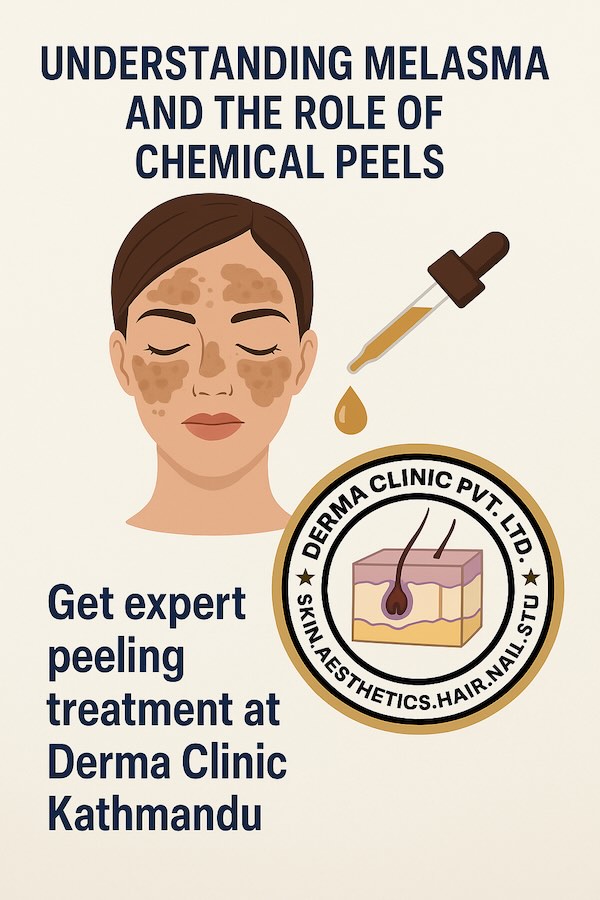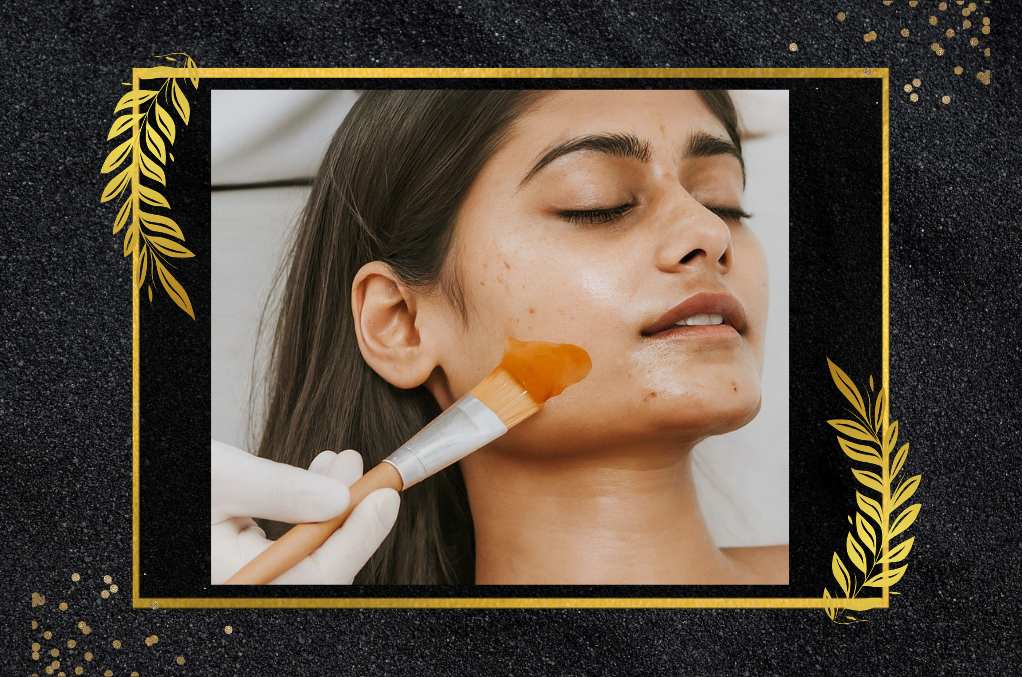Chemical peel treatment is a highly effective solution for melasma, targeting dark patches and uneven skin tone by gently exfoliating damaged skin layers to reveal a clearer, more radiant complexion. Derma Clinic Kathmandu stands out as the leading clinic for chemical peeling treatments in the city, offering expert dermatologist consultations, advanced face analysis, and personalized care for every patient. With a team of experienced specialists and a reputation for excellence, Derma Clinic is the top choice for those seeking safe, professional, and results-driven melasma treatment in Kathmandu.

Melasma is a common skin condition causing brown or greyish patches, usually on the face. These harmless patches can be a source of frustration for many. If you’re seeking solutions for melasma in Kathmandu, you’ve likely heard about various treatments, including chemical peels. But what exactly are they, and can they help?
Chemical peels are procedures that use specific solutions to exfoliate the skin. For melasma, the goal is to remove the outer skin layers containing excess pigment, encouraging the growth of new, more evenly toned skin. Superficial peels are often used as on Skin tone in Nepal as they target outermost layer epidermis. Deep peels are often avoided in south asian skin tone as it can cause post-inflammatory hyperpigmentation (PIH).
Common Peeling agents include:
- Alpha-Hydroxy Acids (AHAs): Water-soluble agents like Glycolic Acid (GA), Lactic Acid (LA), and Mandelic Acid (MA) are frequently used for superficial peels. GA, derived from sugarcane, has the smallest molecular size, allowing for easy penetration. GA peels typically require neutralization with water or a bicarbonate solution to stop their action.
- Beta-Hydroxy Acids (BHAs): Salicylic Acid (SA) is the primary BHA used in peels. Its lipid solubility allows it to penetrate into oil-rich pores, making it particularly effective for acne. SA peels often crystallize on the skin upon solvent evaporation, creating a “pseudofrost” and making them somewhat self-limiting. Lipohydroxy acid (LHA) is a derivative with increased lipophilicity.
- Trichloroacetic Acid (TCA): A versatile agent used in concentrations ranging from 10% to over 50% to achieve superficial, medium, or deep peels. TCA causes protein denaturation, resulting in visible frosting that helps gauge peel depth. Concentrations above 35-50% carry a high risk of complications like scarring and are typically reserved for focal treatment of specific lesions.
- Jessner’s Solution: A classic combination formulation containing salicylic acid, lactic acid, and resorcinol in an ethanol base.It functions as a superficial peel on its own but is often used as a preparatory step before applying TCA or GA to achieve a medium-depth peel.
- Retinoids: Peels using tretinoin (all-trans retinoic acid) are typically superficial and cause minimal discomfort during application due to their mechanism of action involving gene regulation rather than immediate caustic effects.
- Phenol: Used alone (e.g., 88% for medium depth) or, more commonly, combined with croton oil for deep peels. Due to risks, deep phenol peels require careful patient selection, pre-treatment, and monitoring.
- Phytic Acid: A gentler agent with antioxidant properties, often included in combination peels designed for sensitive skin or maintenance.
An Overview of Peels Used for Melasma
A variety of chemical peeling agents have been investigated and are utilized in the management of melasma, with superficial peels being the most common choice due to safety considerations.
- Glycolic Acid (GA): As the most extensively studied agent for melasma , GA peels are frequently used in concentrations ranging from 20% to 70%.They work through keratolysis and possess anti-inflammatory and antioxidant effects.Treatment typically involves a series of peels performed every 2-4 weeks.GA peels are generally considered safe for lighter skin types (Fitzpatrick I-IV) and have shown efficacy, particularly for epidermal melasma.
- Salicylic Acid (SA): Used in concentrations of 20-30% for melasma . SA peels are lipophilic, making them effective for patients with concurrent acne or oily skin. SA also has anti-inflammatory and depigmenting properties. While often reported as safe for all skin types , one source suggests a potentially higher risk of PIH compared to other superficial peels in darker skin.
- Lactic Acid (LA): An AHA typically used in concentrations up to 92% for melasma. It functions similarly to GA by breaking down corneocyte cohesion and also inhibits tyrosinase. LA peels are considered gentle and safe, making them suitable for sensitive skin.
- Mandelic Acid (MA): Another AHA, used in concentrations of 10-50%. Its larger molecular size may lead to slower penetration and less irritation compared to GA. It possesses anti-inflammatory effects and is often used in combination peels.
- Trichloroacetic Acid (TCA): Employed at lower concentrations (10-20%, sometimes up to 35%) for superficial to medium-depth peeling in melasma. While effective, TCA peels generally cause more burning, peeling, and carry a higher risk of PIH compared to GA peels, demanding caution, especially in darker skin types. Concentrations above 25-30% are particularly risky for PIH in these individuals.
- Jessner’s Peel: This combination peel (lactic acid, salicylic acid, resorcinol) is an effective superficial peeling agent for melasma. It can be used alone or as a primer for other agents like TCA to achieve medium depth. It is generally considered safe for various skin types.
- Retinoic Acid (Tretinoin) Peel: Utilized in concentrations of 1-10%. These peels work more slowly by influencing cell turnover and can be particularly beneficial for patients already using topical tretinoin for priming.
- Phytic Acid Peel: A mild agent with antioxidant properties, often found in combination peels. It is considered safe for sensitive and darker skin types and does not require neutralization.
- Combination Peels: Formulations combining multiple agents (e.g., Salicylic + Mandelic acid, GA + TCA, Jessner’s + TCA) are frequently used. This approach may leverage synergistic effects or allow for the use of lower, potentially safer concentrations of individual agents. Superficial combination peels might offer improved tolerability.
3.3. Table 1: Comparative Overview of Common Chemical Peels for Melasma
| Agent | Typical Concentration Range (%) | Usual Depth | Key Mechanism(s) | Efficacy Highlights (Evidence Level*) | Key Risks | Suitability Notes |
| Glycolic Acid (GA) | 20-70 | Superficial | Keratolytic, Anti-inflammatory, Antioxidant | Most studied; Safe & Effective (A); Good for epidermal melasma; Similar efficacy to Tretinoin peel; May be safer than TCA | Irritation, PIH (lower risk vs TCA) | Good general option, esp. Fitzpatrick I-IV |
| Salicylic Acid (SA) | 20-30 | Superficial | Keratolytic, Lipophilic, Anti-inflammatory, Depigmenting | Effective (B); Similar efficacy to GA in some studies; Good for acne/oily skin | Irritation, Dryness, PIH (risk debated) | Good for acne-prone melasma; Caution in dark skin per one source |
| Lactic Acid (LA) | up to 92 | Superficial | Keratolytic, Tyrosinase inhibition | Safe & Effective (B); Gentle; Comparable to Jessner’s | Low irritation | Good for sensitive skin |
| Mandelic Acid (MA) | 10-50 | Superficial | Keratolytic, Anti-inflammatory | Less irritating than GA?; Often used in combination; SA+MA peel comparable to GA | Low irritation | Good for sensitive skin, often combined |
| Trichloroacetic Acid (TCA) | 10-35 | Superficial-Medium | Protein Denaturation (Frosting) | Effective (B); May show rapid initial response; Higher PIH/side effect risk vs GA | Burning, Peeling, PIH, Scarring (higher conc.) | Use low conc. (<25-30%) with caution in dark skin |
| Jessner’s Peel | N/A (Combination) | Superficial | Keratolytic (LA, SA), Resorcinol effects | Effective (B); Comparable to GA; Modified Jessner’s + TCA effective | Irritation, PIH | Generally safe for various skin types |
| Retinoic Acid (Tretinoin) | 1-10 | Superficial | Regulates cell turnover | Effective (C); Slow release; Good for tretinoin-primed skin | Minimal discomfort | Alternative, esp. if primed with tretinoin |
| Phytic Acid | Variable (Combo) | Superficial | Antioxidant, Mild exfoliation | Safe & Effective (C); Often combined; No neutralization needed | Very low irritation | Good for sensitive/dark skin, often in combos |
*Evidence Level/Strength of Recommendation primarily based on Indian Pigmentary Expert Group Consensus: A=Good Evidence, B=Fair Evidence, C=Poor Evidence/Expert Opinion. Other sources corroborate general findings.
How Often Are Peels Done?
Superficial peels, the type most commonly used for melasma, usually require multiple sessions for the best results. Typically, a series of 3 to 8 peels might be recommended, often spaced every 2 to 5 weeks apart.
The Pros and Cons of Chemical Peels for Melasma
Like any cosmetic procedure, chemical peels have potential benefits and drawbacks:
Pros:
- Faster Results: Peels can often speed up the improvement process compared to using only topical creams.
- Removes Pigmented Cells: They effectively exfoliate the skin, helping to shed cells that hold excess melanin.
- Improved Skin Texture: Beyond pigmentation, peels can leave skin feeling smoother and looking more radiant.
- Boosts Topical Treatments: Peels can potentially help topical creams penetrate better and work more effectively.
Cons:
- Temporary Side Effects: Expect some redness, stinging during the procedure, and peeling afterward, similar to a sunburn, especially with superficial peels.
- Risk of Pigment Changes: The most significant risk is post-inflammatory hyperpigmentation (PIH), where the skin darkens after the peel. This risk is higher in individuals with darker skin tones. Less commonly, hypopigmentation (lightening of the skin) can occur, mainly with deeper peels.
- Variable Effectiveness: Results can vary; peels work best for pigment in the upper skin layers (epidermal melasma).
- Requires Multiple Sessions: Achieving desired results usually involves a series of treatments.
Preparing for Your Peel: Pre-Peel Precautions
Proper preparation is key to a successful peel and minimizing risks. This “priming” phase usually starts 2-4 weeks (or longer for darker skin types) before your first peel. It typically involves:
- Using Specific Creams: Your dermatologist may prescribe creams containing ingredients like hydroquinone (considered the gold standard for priming) or retinoids to help stabilize pigment cells and ensure the peel works evenly.
- Strict Sun Protection: Daily use of broad-spectrum sunscreen (SPF 30 or higher) and avoiding direct sun exposure is crucial during priming and throughout treatment.
After the Peel: Post-Peel Care
Following your peel, careful aftercare helps ensure proper healing and protects your results:
- Gentle Cleansing: Use mild cleansers as recommended by your dermatologist.
- Moisturize: Keeping the skin hydrated is essential to prevent cracking and aid healing.
- Strict Sun Avoidance: Protect the treated skin from the sun rigorously. Wear broad-spectrum sunscreen daily, even indoors, and consider wide-brimmed hats when outside.
- Avoid Picking: Do not pick, rub, or scratch the peeling skin, as this can lead to infection or scarring.
- Follow-Up: Attend any scheduled follow-up appointments and resume maintenance topical treatments as advised.
Cost of Chemical Peeling in Kathmandu
Average Cost of Chemial Peeling in Kathmandu starts from Rs 3000 , but price varies depending upon Chemical peel Product, Area involved or treated and more.
Your Partner in Melasma Management in Kathmandu
Melasma requires a careful, personalized approach. Chemical peels can be an effective part of a comprehensive treatment plan, but they must be performed correctly, especially considering the unique skin characteristics of individuals prone to melasma.
At Derma Clinic, we pride ourselves on being the best skin clinic in Kathmandu, offering expert diagnosis and tailored treatment plans for melasma. Our experienced dermatologists understand the nuances of treating diverse skin types and prioritize your safety and results.
Ready to discuss your melasma treatment options? Contact Derma Clinic today at 9801358600 to schedule your consultation and take the first step towards clearer, more confident skin.

